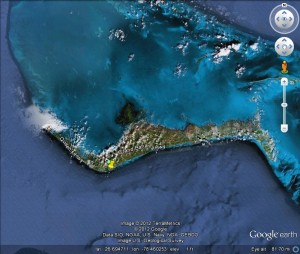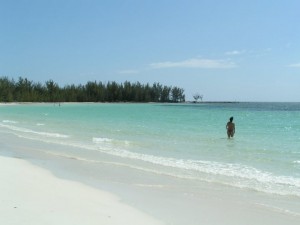22nd May is International Day for Biodiversity and the theme for 2012 is Marine Biodiversity. In celebration, we will be featuring a series of articles on seagrass. This week, Brooke Landry writes about her seagrass explorations while on vacation in Freeport on Grand Bahamas Island.
—————————————————
Photos and text by Brooke Landry
As a dedicated seagrass ranger, I can’t go on vacation anywhere near the ocean without treating my time there as an underwater exploratory mission. Most recently, I visited Freeport on Grand Bahamas Island, where my mother and I foolishly purchased a timeshare several years ago. One of the true pleasures of vacationing in this spot is the exquisite seagrass bed just 40 or so meters off the beach. Owning a timeshare here means that I can do a repeat sampling of sorts and I’m happy to say that I’ve seen very little change in the bed over the past six years. 
The bed is composed of what you’d expect in the clear, shallow, oligotrophic waters of the Bahamas. It’s dominated by Thalassia testudinum with Halodule wrightii and Syringodium filiforme filling in some of the gaps. There’s also a good supply of macroalgae, mostly calcareous greens including Halimeda, Penicillus, and Acetabularia. The grass is fairly dense but patchy and although it’s subject to some disturbance from the rent-by-the-hour jet skis, I have seen neither an expansion nor a decline in the grass itself. What I have seen is an increased number of Diadema antillarum (yah!). Although there is very little coral interspersed in this seagrass bed, there are cinderblocks and as it so happens, long-spined sea urchins love to hide in cinderblocks. I’m assuming the blocks at one time secured buoys for the swim net or served as tie-downs for jet skis, but now there are several just randomly abandoned throughout the bed. In fact, I planned to complain to the resort management about cleaning them up until I realized they were serving as urchin refuge.
 The beach with seagrass shadow in the background.
The beach with seagrass shadow in the background.
Other urchins, mostly West-Indian Sea Eggs, under the mistaken impression that they were invisible because of the dead seagrass, sponges, and random children’s toys attached to their tests, were everywhere in this particular grass bed. Literally, everywhere. It’s an interesting and beautiful sight to see.
On this most recent trip I also spotted a couple of cow-nosed rays swimming peacefully together, just a meter from unsuspecting and oblivious swimmers. This is the kind of thing I generally like to point out to people, but I’ve grown wary of doing so over the years because, as it turns out, not everyone thinks sea critters are as cool as I do. In fact, most people completely freak out at the notion of being in the water with other living things. I’ve seen swimmers go berserk because their feet touched seagrass. Grass!!! Not a spiny urchin or something that could, given the inclination, bite you, but grass! I’m not even kidding. So I chose to let them swim in oblivion and savored the grace of the rays by myself.
In addition to sting rays, octopi, and urchins that are welcome in any healthy seagrass bed in the Bahamas, I saw one not-so-welcome inhabitant: a Lionfish. Having worked with folks down in North Carolina that did extensive research on Lionfish and their invasive destruction of all things pristine, I’ve seen many Lionfish in captivity. I had never actually seen one out in the water though and it took me by surprise. It was hiding in one of the same cinderblocks that the Diadema were using. I had so many mixed feelings when I noticed it – it was almost like seeing a particularly obnoxious celebrity starlet. It was beautiful and I was awestruck, yet I sort of hated it for its indiscriminately destructive behavior. I wanted it to be gone, but really, it couldn’t help that it was born a Lionfish in the wrong place, so I also felt sorry for it. I named her Pandora and tried not to judge her too harshly, because, after all, there is no species on earth more destructive than my own.